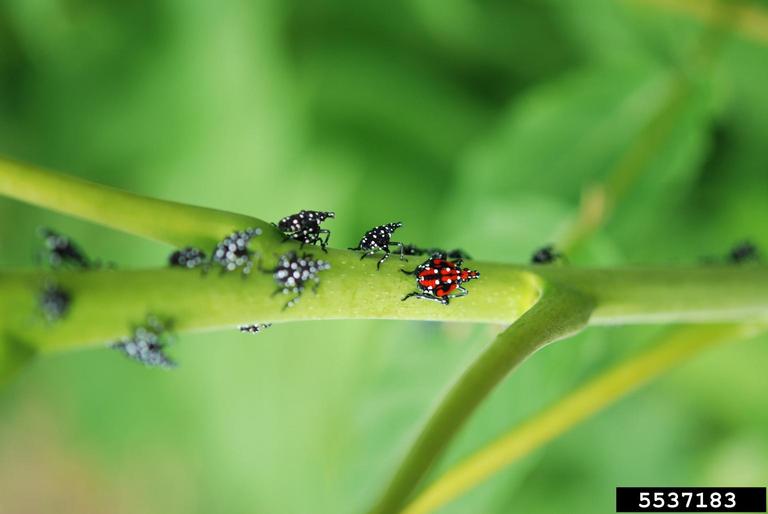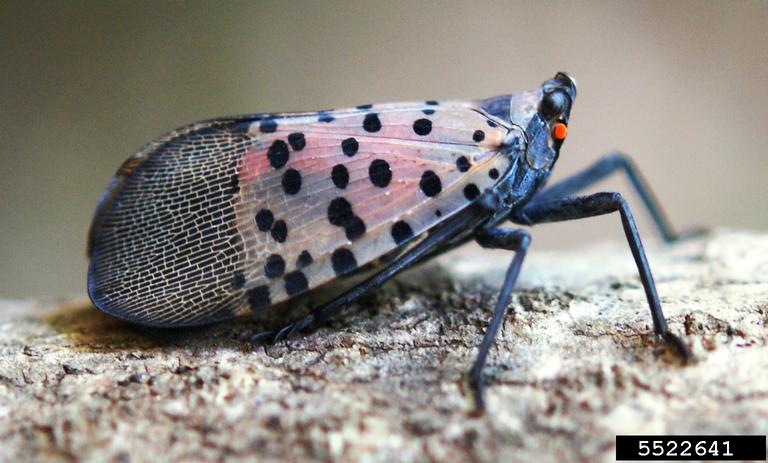by M. Ulmer* (8/20)
Quick Facts….
- Spotted lanternfly has not been detected in Colorado at this time.
- Scouting efforts for this insect are ongoing and continue to be important to minimizing the potential negative effects it could have on flora across the state.
- Please contact your local CSU Extension agent if you believe you have identified SLF on your property.
DESCRIPTION

Spotted lanternfly, Lycorma delicatula, (SLF) is an invasive planthopper with a wide host range (70+ species) that includes fruit trees, grapevines, hops, hardwoods and ornamentals. The spotted lantern fly is native to Asia and was first detected in the US in 2014. While it was initially detected in southeastern Pennsylvania, SLF can now be found in several Eastern US states despite major quarantine efforts. Spotted lanternfly has not been detected in Colorado at this time. Scouting efforts for this insect are ongoing and continue to be important to minimizing the potential negative effects it could have on flora across the state.
Spotted lanternfly have one generation per year. This insect overwinters as egg masses laid by adult females the previous fall (September-November). Eggs hatch the following spring (April-June) giving rise to small black nymphs. Egg masses can be found on trees, rocks, vines, posts, vehicles and equipment with a preferred oviposition host being the Tree of Heaven (Ailianthus altissima). Egg masses are protected with a mud-like covering which cracks over time. Older egg masses appear as ~1-inch-long columns of brownish seed-like deposits containing anywhere from 30-80 eggs (Figure 2).
This insect goes through four nymphal stages before reaching adulthood. Nymphs are 1/8-1/2 inch in length and their coloring is as follows: stages 1-3) black with white spots and stage 4) red with white dots and black stripes (Figure 3). Adults emerge in mid-summer (July) and are black in color with brightly colored hindwings (red, black and white) and grey forewings with black spots, ~1 ½ inches long (Figure 1, 4). Adults are capable of flight but are more often found jumping.
DAMAGE

All nymphal stages of SLF feed on vascular tissue (xylem and phloem) of trunks, cordons and canes of susceptible crops. Grape leaves and clusters are not fed upon by the insect. It might be possible to see large aggregations of this insect on grape stems, especially in the fall.
The excrement produced by SLF, termed honeydew, accumulates on leaf surfaces and can attract ants, bees, flies and wasps. Buildup of honeydew can also be colonized by sooty mold fungi, which serves as a barrier to photosynthesis and can result in a reduction of fruit quality.
Feeding on grapevines has resulted in increased susceptibility to winter injury, reduced fruit set the following year and vine death.

MONITORING
Vineyards and neighboring woodlands should be monitored for adult SLF from late July-November. Nymphs may be present in early summer, but they can be difficult to see. It is important to also scout and monitor tree-of-heaven, the highly desirable host for SLF. Monitoring can be done with visual checks or by using sicky bands wrapped around trees.
Banding can be used both as a monitoring tool and a management tool. Banding is most effective on nymphal stages while adults have been known to avoid the tape. See the Penn State Extension page for more details on banding.
Please contact your local CSU Extension agent if you believe you have identified SLF on your property.
MANAGEMENT
Biological control
In the United States, there are no known natural enemies of SLF thought to reduce populations.
Cultural control
Removal of attractive host plants is recommended, especially tree-of-heaven. Tree-of-heaven should be treated with a systemic herbicide to stop reappearance. Removal of wild grapes, other wild vines and weeds is recommended to reduce available habitat for SLF.
Banding nearby trees
See Monitoring section above
Mechanical destruction of eggs
Other approaches to kill SLF include 1) scraping SLF egg masses with a hard, flat tool into an alcohol solution and 2) physical destruction and/or smashing of egg masses by applying even pressure to entire egg mass (causes eggs to burst).
Destruction of eggs will reduce spring nymph populations. Egg masses can be found on numerous surfaces, including tree-of-heaven, rocks, trees, fence posts, and outdoor furniture in addition to the underside of cordons and on wooden and metal vine posts.
Chemical control
Should you believe you have SLF on your property, please contact your local CSU Extension agent for confirmation. Penn State has advised on chemical control tactics (Table 1). Always read and follow the product label and be sure to comply with Colorado Department of Agriculture regulations.
Table 1. PennState Extension Spotted laternfly chemical control.

Control method: S = systemic; C = contact; I = ingestion;
Longevity rating: * = < 1 day; ** = 3-7 days; *** = 10-14 days; **** = 14-21 days; Activity: + = slight; ++ = moderate; +++ = good; ++++ = excellent; Toxicity to bees: L = low; M = medium; H = high.
Registrations and labels may change, and human error is always possible. You must read and follow the most current label before applying any pesticide. The trade names listed here are examples of products that have been tested on SLF; this list is not an endorsement of any product. Other products with the same active ingredient and rates will likely offer similar control as what is shown above.
References
- https://extension.psu.edu/spotted-lanternfly-management-in-vineyards
- https://extension.umd.edu/resource/spotted-lanternfly-slf-i-background
- https://extension.umd.edu/resource/spotted-lanternfly-slf-ii-scouting-and-management
- https://daily.sevenfifty.com/the-increasing-threat-of-the-spotted-lanternfly/
- https://extension.psu.edu/spotted-lanternfly-management-resources
*Miranda Ulmer, Colorado State University Extension State Specialist – Viticulture. (8/20)






